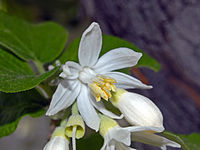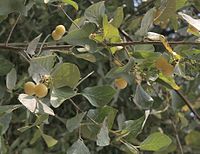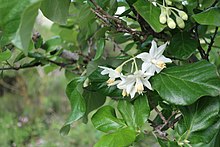| Styrax officinalis | |
|---|---|

| |
| S. officinalis in the Menashe hills of Israel | |
| Scientific classification | |
| Kingdom: | Plantae |
| Clade: | Tracheophytes |
| Clade: | Angiosperms |
| Clade: | Eudicots |
| Clade: | Asterids |
| Order: | Ericales |
| Family: | Styracaceae |
| Genus: | Styrax |
| Species: | S. officinalis |
| Binomial name | |
| Styrax officinalis L. | |
| Synonyms | |
Styrax officinalis is a species of shrub in the family Styracaceae, commonly called the storax tree, or Snowdrop bush.
Description
Styrax officinalis is a deciduous shrub reaching a height of 2–5 metres (6 ft 7 in – 16 ft 5 in). It has a simple, relaxed form, with very thin elliptical leaves 5–10 cm (2–4 in) long and 3.5–5.5 cm (1+1⁄2–2 in) wide, alternate and widely spaced on thin, reddish stems, with a tight, dark bark on basal stems. A small very light green, stalked axillary bud is associated with each leaf.

The inflorescence is short and few-flowered. The flowers are axillary, bell-shaped, white and fragrant, about 2 cm (1 in) long. The corolla has 5–7 petals and many yellow anthers, the calyx is 5-lobed. Flowering period extends from spring to summer (May–June).
Styrax officinalis subsp. redidivus, Styrax officinalis subsp. fulvescens (both native to California) and Styrax officinalis subsp. jaliscana (native to Mexico), were included here, but recent molecular analysis has suggested that they may be diverged to the point of being separate species.

Distribution
This species is native to southern Europe and the Middle East. It prefers dry rocky slopes, woods and thickets at an elevation up to 1,500 metres (4,900 ft) above sea level.

Uses
This plant is the "official" source of styrax (storax), a herbal medicine known from ancient times; it was identified as such by Linnaeus. Some believe its oleoresin to have been the stacte used together with frankincense, galbanum, and onycha to make Ketoret, the Tabernacle incense of the Old Testament. Averroës referred to the reddish-brown oleoresin or exudate taken from the Storax tree (Styrax officinalis, syn. Liquidambar styraciflua). Ibn Ǧanāḥ (c. 990–c. 1050), speaking of the biblical incense galbanum, wrote in his Sefer Ha-Shorashim, s.v. ח-ל-ב (end): "And then there is ḥelbanah (galbanum) which is called in Arabic lūbnī," meaning, the resin of the storax tree. Some speculate that the storax of the ancients was probably extracted from a different tree, Liquidambar orientalis which grows wild in northern Syria. This may be the biblical balm, though other sources conclude that the biblical balm is balsam (opobalsamum).
References
- ^ Hassler, Michael (1994). "World Plants. Synonymic Checklist and Distribution of the World Flora". Version 25.01; last update January 2nd, 2025. www.worldplants.de. Retrieved January 7, 2025.
- "The Plant List: A Working List of All Plant Species". Retrieved 27 September 2014.
- ^ Plants for a Future
- "Mildred E. Mathias Botanical Garden Newsletter". 5 (2). 1999.
{{cite journal}}: Cite journal requires|journal=(help) (includes helpful photos of the features described) - ^ Peter Frisch (March 1996). "Isozyme Analysis of Intercontinental Disjuncts within Styrax (Styracaceae): Implications for the Madrean-Tethyan Hypothesis". American Journal of Botany. 83 (3): 342–355. doi:10.2307/2446169. JSTOR 2446169.
- James A. Duke (2007). Duke's Handbook of Medicinal Plants of the Bible. p. 447. ISBN 978-0-8493-8202-4.
- Jehuda Feliks (2007), "Storax", Encyclopaedia Judaica, vol. 19 (2nd ed.), Thomson Gale, p. 238
External links
| Taxon identifiers | |
|---|---|
| Styrax officinalis |
|